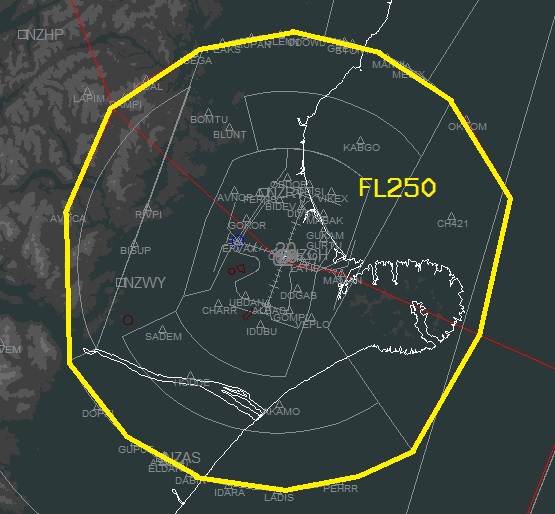Christchurch TMA
Section 1: General
1.1 Area of Responsibility:
NZCH_APP (Christchurch Approach) is responsible for all controlled airspace within their designated area of responsibility (see diagram), excluding Christchurch Tower when that unit is online.
Controls up to FL250.

1.2 Frequency and Sector Information:
| Callsign | NZCH_APP |
| Primary Frequency | 126.100 MHz |
| RTF Designator | Christchurch Approach |
| Sector Name | Christchurch Terminal |
| Sector Abbreviation | CAT |
| Telephone Designator | Christchurch Terminal |
1.3 Opening NZCH_DEP
Please read the Departure TMA Guidelines found here.
When both NZAA_APP & NZAA_DEP are online:
1.3.1 NZCH_APP is responsible for all IFR/VFR arrivals into the TMA.
1.3.2 NZCH_DEP is responsible for all IFR/VFR departures out of the TMA.
1.3.3 Where an aircraft is departing & arriving within the TMA the aircraft should be passed from NZCH_DEP to NZCH_APP half way to the destination airport.
1.3.4 Use of appropriate SID's and STAR's is encouraged as these provide separation. Once an aircraft on approach has passed abeam the upwind threshold then the aircraft can be vectored as required and usually without reference to the DEP controller. The APP controller can then use the STAR, shorten the STAR, Vector, use speed control etc.
1.3.5 NZCH_APP & NZCH_DEP may need to co ordinate between each other, due to the possibility of departing & arriving aircraft conflicting with each other.
1.3.6 It is totally at the discretion of NZCH_APP & NZCH_DEP what solutions they use to manage conflicts. After all a TMA controller is already competent to control the whole TMA alone. The only difference here is, you need to co ordinate a solution between both of you, when such a conflict is likely to occur.
For example in an event where the arrival & departure cross at point X, you may agree until point X is passed, that APP will not descend below 8000 & DEP will not climb above 6000.
1.3.7 Note: Some tracks mainly north or west bound cross arrival tracks.
Above all, it is a requirement that APP and DEP controllers operating in shared airspace do so with respect and courtesy for each other.
Section 2: Arrivals
2.1 ATC Speed Requirements
Unless otherwise approved by ATC, arriving aircraft:
must not exceed 250 kt IAS below 10,000 ft within 30 NM of Christchurch International Airport and comply with speed requirements promulgated on STAR charts; and
must fly an instrument approach at the promulgated speeds, and additionally an air traffic management requirement to fly MNM 150 kt IAS to 5 NM on final approach. If unable to comply advise ATC with preferred speed.
Aircraft unable to follow promulgated RNAV STAR procedures will be given radar vectors or alternative routing by ATC.
Section 3: Departures
Section 4: Christchurch Tower Procedures
4.1 Area of Responsibility:
Christchurch Tower is responsible for all aircraft within the Christchurch CTR/C, SFC-1500ft.
4.2 IFR Departures:
Christchurch shall request an IFR release from Christchurch Terminal for all departures prior to clearing the aircraft for take off.
Aircraft must have commenced the turn on the SID before any other departure may be cleared for take-off.
Christchurch Tower shall annotate the flightplan to display the SID being used by the aircraft.
4.3 IFR Arrivals:
Christchurch Terminal shall restrict aircraft on a visual approach to 2,000ft unless otherwise coordinated.
Aircraft on an instrument approach may descend below 2,000ft in accordance with the published profile.
4.4 Transfer of Control:
Departures: Airbourne, unless otherwise coordinated.
Arrivals: Within 10 CH DME.
4.5 Transfer of Communications:
Departures: In accordance with the SID instructions (usually 1,500ft).
Arrivals (on an instrument approach): At ALBAD or DIVSU, established on a straight-in approach.
Arrivals (on a visual approach):
4.6 Unattended Procedures:
When Christchurch Tower is offline, Christchurch Terminal assumes the role of NZCH_TWR.

